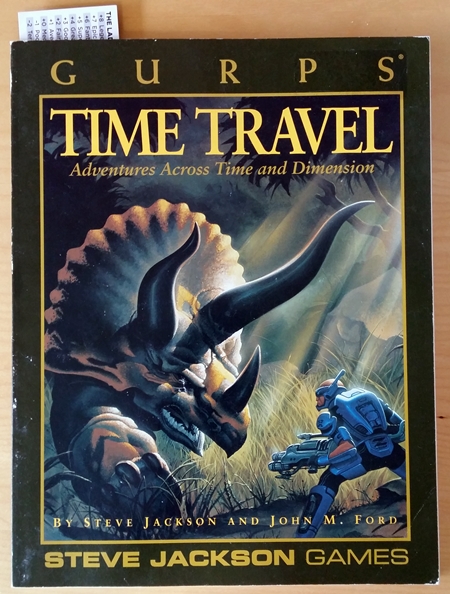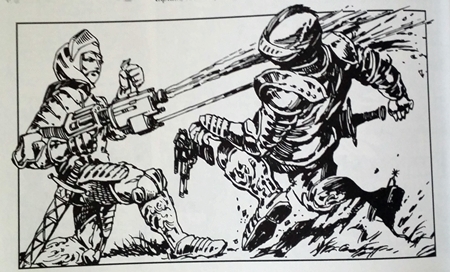The more of GURPS Time Travel (paid link) I read, the more I love this book. Pound for pound, it’s one of the best gaming books I’ve read, GURPS or otherwise.

Leaving aside the “idea nuggets” scattered throughout, Time Travel offers up six settings. Time Corps is brilliant, and does more in 13 pages than most setting books do in hundreds. Infinite Worlds is the other setting which gets a longer treatment (and which later got blown out into its own book, GURPS Infinite Worlds (paid link), which I haven’t read yet).
But there are also four mini-settings, which collectively take up just 16 pages. These sounded neat, but I figured the real money was in the two more complete settings. Not so! These mini-settings are fantastic in their own right.
In the Cube
The first mini-setting is a short one, just 3 pages, and casts the PCs as lost time-travelers jumping randomly throughout history. They’ve got a support team back home, in the present; their time machine, the Hypercube, is also in the present.
The PCs can contact the scientists at home[1], although it’s not a quick or automatic process because the Hypercube isn’t a stable, smoothly-operating machine — it’s kind of a mess. The home-timers can also send the PCs stuff.
This tight little setup is a big, shiny hook for a rollicking time-romp. The PCs are yanked into another time — whatever sounds fun, perhaps a historical tipping point or the middle of a raging battle — and have to make their own way until the scientists can establish contact and give them support.
It’s very Quantum Leap, but there’s also some Star Trek: Voyager in the mix — because of course the PCs would eventually like to return home.
Eternity’s Rangers
The opposite is true of Eternity’s Rangers: The PCs can’t return home, because in their home time, they’re all dead. This mini-setting gets a whopping 8 pages, and it’s my favorite of the bunch.

Eternity’s Rangers, as the name suggests, is a military campaign. The Recruiters, a mysterious group with access to time travel, controls the Rangers, a military unit composed of soldiers from all along Earth’s timeline. Each ranger was snatched from the moment of their death and offered a choice:
I died in the Ardennes, during what you call the Battle of the Bulge. Ran into an enemy patrol in the middle of the night. There was fire; too much fire. Then a voice said, “If you want to come out of this alive, friend, take three steps to the left.”
The Recruiters send the Rangers on missions throughout time, always with specific objectives: “Turn the tide of this battle in favor of the Visigoths; everyone gets an assault rifle and 10 magazines,” or “Rescue this prisoner, but don’t reveal that you’re time travelers.” And if someone does cotton to your unnatural origins? They’re probably going to have to die, because the Recruiters are ruthless about obedience to their orders.
I could go on and on about this setting (it’s so damned good!), but instead I’ll share just one more favorite element: the pickup. Every mission comes with a pickup time and location, and if you’re not there, you’re stuck forever . . . unless you’re important enough to merit a follow-up rescue mission, of course!
The Order of the Hourglass
This mini-setting is Roaring Twenties pulp adventure + psychic time travel + time-hopping adventurers opposed by shadowy secret societies. Think League of Extraordinary Gentlemen (paid link), but with time travel.
By default, the PCs use time travel to study or explore the past — but their enemies use it for evil. Unscrupulous time travelers set up bases in the past, altering history for their own ends. Some have figured out that committing murder in the past leaves no loose ends, and have no compunctions about killing those who oppose them — like the PCs.
It’s a simple concept, but a rich one. There’s no vast temporal conspiracy, just ragtag time-explorers getting into trouble, often at the hands of a diverse bunch of enemies. There’s a ton of room to maneuver, which is one of the things I like about this setting.
The Horatio Club
Imagine if the Diogenes Club were actually a pan-dimensional cross-time nexus frequented by all manner of strange people, and you have the Horatio Club.
No one arrives there by accident, and the club’s many doors lead to myriad universes which, generally, feature entertaining problems that need to be solved. It’s a bit heavy-handed for my tastes, but the bones are intriguing — and like In the Cube, it’s a marvelous excuse to romp through time and space without worrying overmuch about the consequences.
This book just keeps on delivering
I’m on to the Infinite Worlds portion of GURPS Time Travel (paid link) next, and a bit further on down the line I’ll be checking out the much longer standalone IW book. Based on the strength of the five Time Travel settings I’ve read, I’m excited to see what that one’s like, as well!
[1] The book also suggests another option: Everyone plays two characters, a time-wanderer and a scientist in the present.
